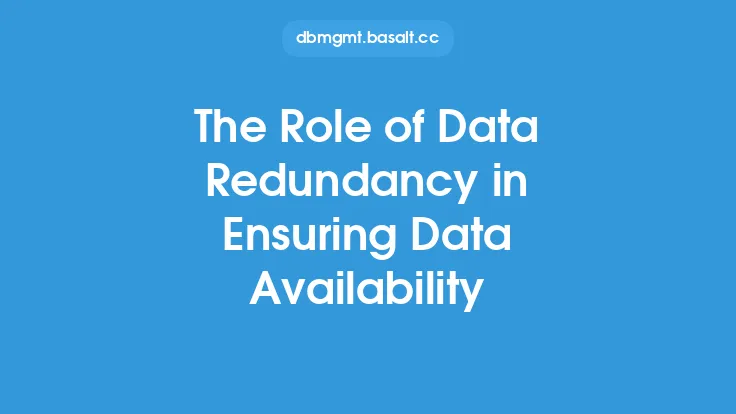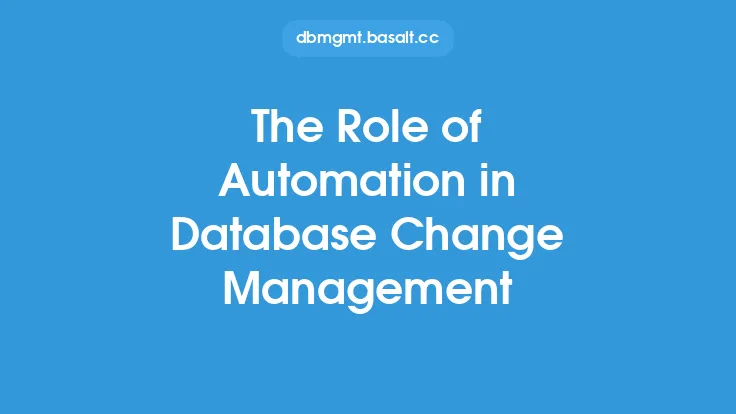Database high availability is a critical aspect of modern computing, as it ensures that data is always accessible and usable, even in the event of hardware or software failures. One key component of achieving high availability is backup automation, which involves using specialized tools and software to automatically backup and recover database data. In this article, we will explore the role of backup automation in ensuring database high availability, including the benefits, challenges, and best practices for implementing backup automation in a database environment.
Introduction to Backup Automation
Backup automation is the process of using software or tools to automatically backup and recover database data, without the need for manual intervention. This can include scheduling backups, verifying backup integrity, and automatically recovering data in the event of a failure. Backup automation tools can be used to backup a wide range of database types, including relational databases, NoSQL databases, and cloud-based databases. By automating the backup process, database administrators can ensure that data is consistently backed up and readily available for recovery, reducing the risk of data loss and downtime.
Benefits of Backup Automation
Backup automation offers several benefits for database high availability, including:
- Improved data protection: Automated backups ensure that data is consistently backed up, reducing the risk of data loss and corruption.
- Increased efficiency: Automated backups can be scheduled to run during periods of low activity, reducing the impact on database performance and minimizing the need for manual intervention.
- Reduced downtime: Automated recovery processes can quickly restore data in the event of a failure, reducing downtime and minimizing the impact on business operations.
- Enhanced scalability: Backup automation tools can be easily scaled to meet the needs of growing databases, ensuring that data is always protected and available.
Challenges of Backup Automation
While backup automation offers several benefits, there are also several challenges to consider, including:
- Complexity: Backup automation tools can be complex to configure and manage, requiring specialized skills and knowledge.
- Cost: Backup automation tools can be expensive, especially for large or complex databases.
- Integration: Backup automation tools may require integration with other database management systems and tools, which can be time-consuming and challenging.
- Security: Backup automation tools must be properly secured to prevent unauthorized access to sensitive data.
Best Practices for Implementing Backup Automation
To ensure successful implementation of backup automation, several best practices should be followed, including:
- Develop a comprehensive backup strategy: Define a clear backup strategy that includes scheduling, retention, and recovery procedures.
- Choose the right backup automation tool: Select a backup automation tool that meets the needs of the database environment, including scalability, performance, and security.
- Configure and test backups: Configure backups to run automatically and test them regularly to ensure integrity and recoverability.
- Monitor and maintain backups: Continuously monitor and maintain backups to ensure they are running correctly and data is being properly protected.
Technical Considerations for Backup Automation
When implementing backup automation, several technical considerations must be taken into account, including:
- Backup types: Choose the right type of backup, including full, incremental, and differential backups, to meet the needs of the database environment.
- Backup storage: Select a suitable backup storage solution, including disk, tape, or cloud-based storage, to meet the needs of the database environment.
- Backup compression and encryption: Use compression and encryption to reduce storage requirements and protect sensitive data.
- Backup verification: Regularly verify backups to ensure integrity and recoverability.
Conclusion
Backup automation plays a critical role in ensuring database high availability, by providing a reliable and efficient means of backing up and recovering database data. By understanding the benefits, challenges, and best practices for implementing backup automation, database administrators can ensure that their databases are always protected and available, reducing the risk of data loss and downtime. Whether using specialized backup automation tools or custom scripts, the key to successful backup automation is to develop a comprehensive backup strategy, choose the right tools, and continuously monitor and maintain backups to ensure data is always protected and available.





